Evan William Jones
(1880 - 1950)

Evan Jones, circa 1932.
Photo from www.alaskahistory.org
Evan Jones was nick-named "Half-Pint" because of his lack of physical stature. But to early Alaskans, he was the "Father of Alaska Coal Mining" and respected as a man as well as a miner. His first experience in the coal mines was as a trapper boy, opening and closing fire doors, at age 12 in his native Wales. Although he had other early jobs, Evan Jones was a coal miner for more than fifty years.
Jones was born March 5, 1880 in Aberdare, Wales. His mother died when Evan was two years old and his father died in the early 1890's, leaving Evan on his own. Attempts at earning a living in London were unsatisfactory, as was his experience in the wheat fields of Manitoba, Canada, where it was too hot for him. His first experience in a Canadian coal mine camp was at Fernie in British Columbia, where his first job was as a bull cook.
During his early employment as a miner at Fernie, Jones took a correspondence course in coal mining from the U.S. Bureau of Mines and received his papers as fire boss. The training was put to use quickly when the mine exploded, killing over 100 men.
Disaster followed Evan to his next job, in a coal mine at Frank, Alberta. On April 29, 1903, Turtle Mountain slid, covering the town of Frank and the mine. The force of the slide was sufficient to throw house-size limestone boulders two miles, to opposite side of the mountain. The slide killed 66 people. Jones was underground, and was the first man to dig his way out.
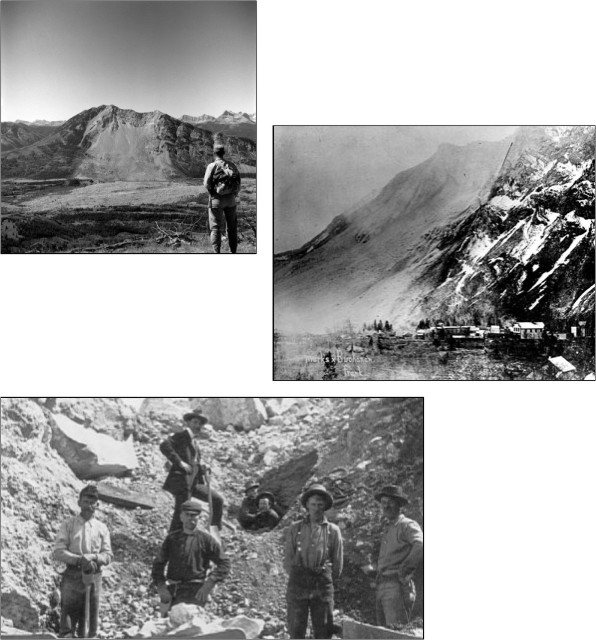
Views of the Turtle Mountain landslide in Frank, Alberta, Canada, circa 1903.
Photos from (clockwise from top) en.wikipedia.org, www.thecanadianencyclopedia.com, franktimes.ucalgaryblogs.ca
Between 1903 and 1917, Jones worked in coal mines in Iowa, Missouri, and Washington. An aspect of his Welsh heritage emerged to his benefit - like many Welsh miners, Jones loved to sing, and he had an excellent voice. His voice instructor was fellow countryman David Morgan. David had a daughter named Bronwen, who became Mrs. Evan Jones in 1906. Another voice student of Morgan's was George Watkins Evans, who was mine inspector for the State of Washington. George Evans lined up Evan Jones for his first Alaska coal mining job, as mine superintendent at the Doherty Mine on Moose Creek east of Palmer, Alaska. Jones moved on from the Doherty Mine when he became superintendent of the Eska and Chickaloon Mines on the recommendation of Frederick Mears of the Alaska Engineering Commission.
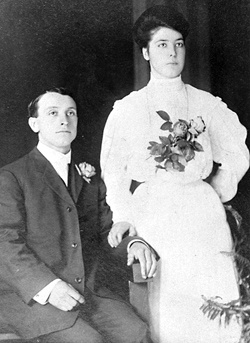
Evan and Bronwen Jones, circa 1906.
Photo from www.alaskahistory.org
In 1920, Evan Jones, with Anchorage pioneers Z.C. Loussac and Oscar Anderson, a hotel man by the name of Collins, Dr. Blyth, a dentist, and Dr. Boyle, an M.D., leased 2240 acres on the south slope of Wishbone Hill and opened the Jonesville mine of the Evan Jones Coal Company, with Evan Jones as general manager. As a privately owned mine, Jonesville could supply coal in Anchorage. A rival coal mine, the Eska, could only sell to the Alaska Railroad (ARR). Jonesville quickly developed into the largest coal mine in Alaska. Recognizing the superiority of the mine at Jonesville, the ARR closed Eska and extended a spur line into Jonesville.
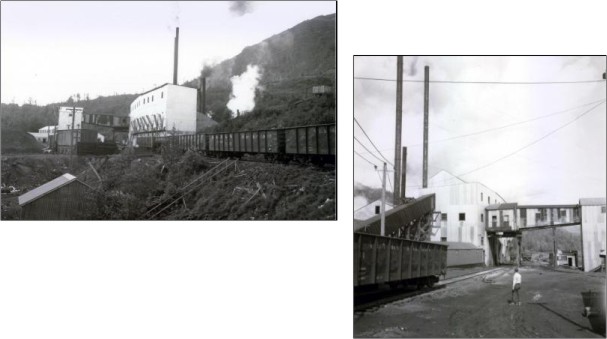
Views of the Evan Jones Coal Mine, date unknown.
Photos from www.alaskarails.org
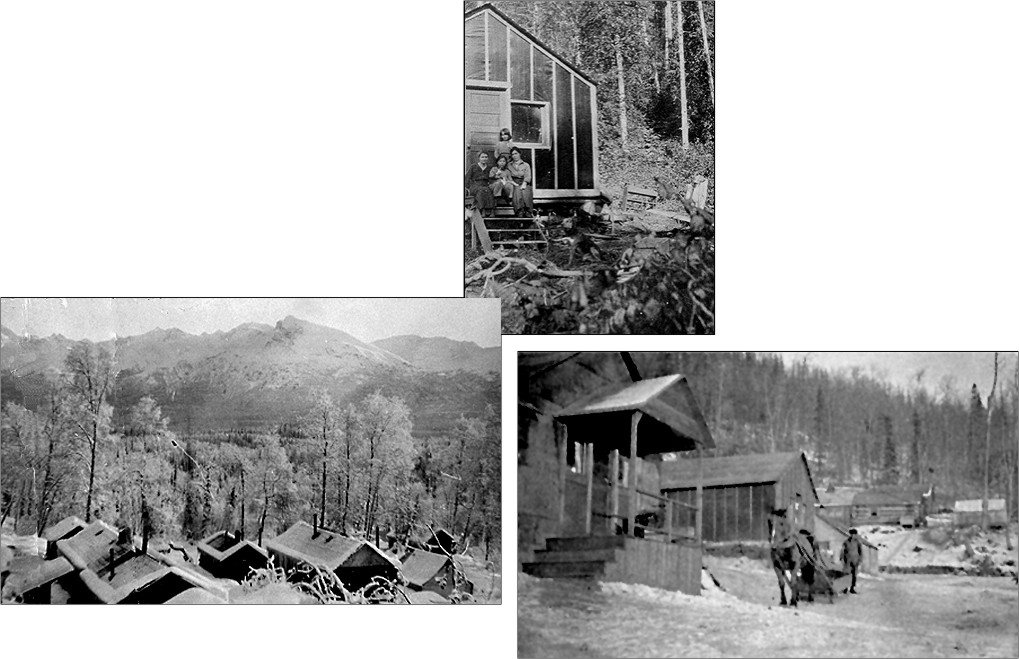
Views of the Jonesville Mine Camp, circa 1921-1922, including the Jones family cabin at the top.
Photos from www.alaskahistory.org
In 1924, the Jones family, now with three daughters, Vanny, Vivian, and Martha, moved to Seattle so Vanny could attend high school, but they were back in Alaska by 1926, this time for Evan to manage Cap Lathrop's coal mine at Suntrana near Healy. Another daughter, Margaret, joined the family during the Suntrana period. The tall Lathrop and half-pint Jones must have been an unusual pair. But in addition to a common interest in coal mining, the two men loved cigars and were notably thrifty. After one spring flood, both Lathrop and Jones were seen rolling out their water soaked cigars to dry.
During the 1930s, Jones was affiliated with several mines, most notably Wishbone Hill. Wishbone Hill and the nearby Premier Mine were connected by narrow gauge railroad to the standard gauge track that went to Jonesville and the Eska mine. Wishbone was generally a faithful producer, but an engineer known as "Gasoline Gus", ran the train off the tracks after a New Year's Eve party in Palmer, and it was several months before the mine reopened. A major flood finally caused the Wishbone Hill Coal Mine to close.
Past age 60, Evan was called on for one more major task during World War II. At the request of Colonel Ohlson, general manager of the Alaska Railroad, Evan reopened and operated the Eska Mine, working tirelessly to produce coal for the railroad and military bases in Anchorage. In addition to Colonel Ohlson, General Buckner recognized the importance of Evan's work, a recognition that Evan turned into one personal favor. Ordinarily Jones was reticent to ask for favors, but in this case his youngest daughter Margaret wanted to marry a soldier, Jack Bennett. Evan approached General Buckner to see if Jack could have the weekend off. The next day Bennett was approached by a phalanx of officers who told him that he could have a week for a honeymoon.
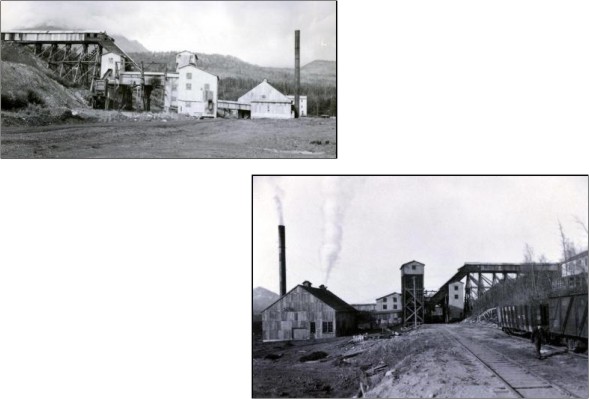
Views of the Eska Coal Mines, date unknown.
Photos from www.alaskarails.org
Later in the 1940s, Jones opened a mine at Houston, Alaska, and also worked at the Buffalo and Premier Mines near the Wishbone Hill Mine. His last major effort began in 1946 when, with a silent partner in South America, he formed the Homer Coal Company. Jones drove two tunnels, built tipple, bunkhouse, shops and other support buildings and planned a dock below the mine in order to barge coal to Anchorage. The Anchorage market did not materialize and many people in Homer found it more convenient to pick coal off the beaches than buy it from the mine.
Evan died peacefully in Homer on March 27, 1950. Only a week before his death Evan had attended the AIME (Mining and Metallurgical Engineers) meeting in Fairbanks where he was recognized for his pioneer work in Alaska coal mining.
By Charles C. Hawley, 1999.